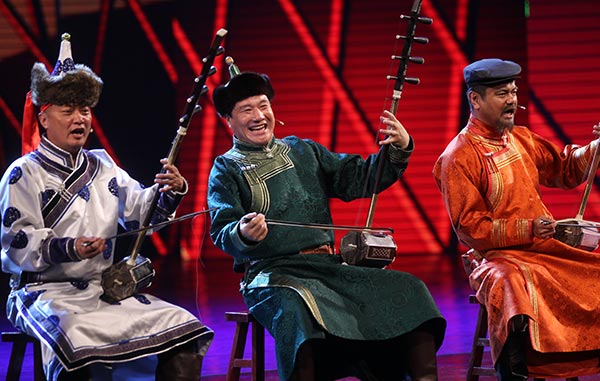

 |
| Ulan Muqir Art Troupe from the Inner Mongolia autonomous region stages two shows in Beijing in May. Zou Hong / China Daily |
A small art troupe founded six decades ago has grown into a household name in the Inner Mongolia autonomous region.
In the 1950s, Ulan Muqir Art Troupe was created by nine young musicians, who toured remote villages on horses and performed traditional Mongolian music and dances for nomadic families.
Ulan Muqir literally translates as "red burgeon", and today's performers of the troupe still tour the region's villages and entertain nomadic families, but their fame has spread around the world.
On May 16 and 17, nearly 100 singers and dancers from the troupe performed at Beijing's Poly Theater. Their show, titled Ulan Muqir on the Grassland, depicted the history and development of the art troupe.
"Being from the region allowed me to embrace the culture of Inner Mongolia and being a member of the troupe showed me where I belonged," Nasun, the art troupe's president, who is also a renowned tenor, tells China Daily.
The 54-year-old was born in Tongliao, in eastern Inner Mongolia and joined the troupe in 1975.
He says there are 74 branch troupes across Inner Mongolia and actors give around 100 shows every year to local nomadic people.
"I can still recall the days when I toured with the troupe in the early '80s. We sat on the back of pickup trucks for hours. The sky was blue, and we couldn't help but sing the folk songs," Nasun says.
The vastness of Inner Mongolia and the lack of entertainment options for people living there, made their lives lonely.
"The nomadic people were very excited about our visits," Nasun recalls. "We didn't have a formal stage. The audience just sat on the grass. Usually, the performances became a big party with local people joining in."
For him, the rewarding part about touring isn't just about sharing art with nomadic families but also about gaining inspiration for the music and dance.
During a tour in 1985, he went to a village and met an elderly local man, who told him a story about his friendship with a solider from Shenyang, capital of Northeast China's Liaoning province, decades ago. The solider gave the old man a handmade saddle when they bid farewell.
The story inspired Nasun to write Carved Saddle, a song that later became one of his most popular numbers.
Now, every year, Nasun recruits young singers and dancers for the troupe. The troupe has also designed a new repertoire, which is mostly based on the daily lives of Mongolian people, especially the lives of nomadic families, and has combined contemporary musical elements with folk songs of the region.
Haimu, a 25-year-old khoomei (a local variant of overtone singing) singer, joined the troupe three years ago. Along with a six-member band, he performs fast songs and soft ones that he writes-all while playing the horse-head fiddle.
"Although I learned the piano since childhood and grew up listening to various kinds of music, to me, the folk music of Inner Mongolia is the root," he says.
"Performing in remote villages is pleasant. I feel at home on the boundless grasslands, and the warm people there make me feel fulfilled."
Yuan Hui contributed to the story.
 |
 J-11 fighters in air exercise
J-11 fighters in air exercise Beauties dancing on the rings
Beauties dancing on the rings Attendants-to-be join Mr. & Miss Campus Contest
Attendants-to-be join Mr. & Miss Campus Contest Beijing's toughest anti-smoking law takes effect
Beijing's toughest anti-smoking law takes effect Family lives in cave for about 50 years in SW China
Family lives in cave for about 50 years in SW China PLA soldiers operating vehicle-mounted guns in drill
PLA soldiers operating vehicle-mounted guns in drill Blind carpenter in E China's Jiangxi
Blind carpenter in E China's Jiangxi China hosts overseas disaster relief exercise for the first time
China hosts overseas disaster relief exercise for the first time 20 pairs of twins who will become flight attendants in Sichuan
20 pairs of twins who will become flight attendants in Sichuan Obama is sowing discontent in S.China Sea
Obama is sowing discontent in S.China Sea Rescuers work through night to reach cruise ship survivors
Rescuers work through night to reach cruise ship survivors Driving through limbo
Driving through limbo Facing down MERS
Facing down MERSDay|Week